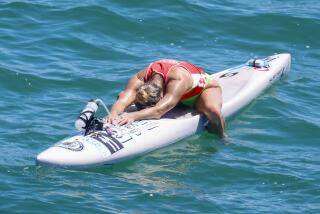A Big Race With Small Rewards
It crosses a continent, but the Race Across America operates with little exposure and even less money.
Orange County contractor John Marino, founder and director of the 2,930-mile race, estimates the event’s annual budget at about $60,000. While many riders spend more than $10,000 on equipment and other preparations, the 1991 winner’s purse amounted to about $2,250 in cash, a $500 bicycle and an estimated $3,000 in goods and services coaxed from sponsors.
This year’s route was more than twice as long as the Iditarod dog-sled race in Alaska, and 500 miles longer than the much-celebrated Tour de France, in which the cycling mileage is broken up to allow sleep and recovery time between daily stages.
But there were no major sponsors, no network television coverage. ABC Sports, which produced specials on the event from 1982 to 1986, backed away, citing production costs. McDonald’s signed on in 1986, then dropped the race after its television prospects dimmed.
“I thought we were done,” Marino recalled recently.
To mainstream America, they were. The conclusion of this year’s race rated just two sentences in the rear of USA Today sports pages, under the heading “Elsewhere.” Most cycling magazines have given the race passing notice at most.
Marino cited apathy in the cycling industry in explaining the 10-year-old race’s low profile, and asserted that some traditionalists resent the attention RAAM enjoyed in its early years.
There are other theories, as well.
“Americans want to see a start and a finish,” suggests George Gring, a seven-year volunteer, at the race’s Prescott, Ariz., time station. “They won’t go out and stand on a hill and watch them go by. They don’t care.”
More to Read
Sign up for Essential California
The most important California stories and recommendations in your inbox every morning.
You may occasionally receive promotional content from the Los Angeles Times.











